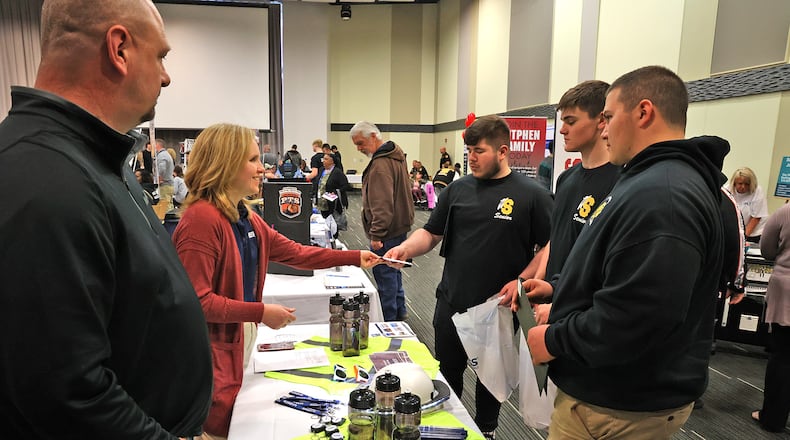Employers have been grappling with the issue of filling positions for some time. But the problem was exasperated during the COVID- 19 pandemic when records number of people left the workforce, officials said.
“There are more openings than there are people right now to go into the workforce,” said Amy Donahoe, the director of workforce development for the Greater Springfield Partnership.
In Clark County the unemployment rate went from 5.2% in January to 4.4% in February and then to 4.3% in March. For Champaign County, that rate steadily decreased from 4.7% in January to 3.9% and then to 3.8% in March, according to the Ohio Department of Job and Family Services.
The number of Clark County residents estimated to be employed increased from 59,500 in January to 60,500 in March. In Champaign County, that number went from 18,300 people to 18,700 people.
The labor shortage has also led to increased competition in attracting labor and retaining skilled employees. That has led to some companies reexamining their offerings, including pay, benefits, company culture and work/life balance.
More companies are partnering with local colleges and institutions that provide training and credentials and have focused on promoting employees from within as well as offering inhouse training opportunities.
“(Employers) are very open to training an individual to do the type of work that they need,” Donahoe said. “Of course, you will still have your skilled trades or types of jobs that require education. A lot of companies are working very closely with the colleges in our region to really latch on and become part of the programming that they are offering.”
Companies are also expanding the ways they recruit and train employees. That includes connecting with local high school and even middle school students. In addition, employers are relying on more social media engagement and traditional recruiting methods such as job fairs.
About 60 employers attended the annual Clark County Job Fair in downtown Springfield on Thursday. Those employers represented a wide array of industries that included manufacturing, healthcare, retail, customer service, food and banking. They were also looking to fill a variety of positions including entry level and ones that require more experience, education or training.
The event was hosted by the Greater Springfield Partnership and Ohio Means Jobs Clark County.
Some of the companies represented at the event have been working to navigate ongoing labor shortages.
Companies such as Benjamin Steel, which has a facility in Springfield, are usually looking to fill 15 to 20 positions locally at any given time.
Trouble attracting labor is across the board and not tied to one particular skill set for the company, said Ben Hattemer, the director of southern operations for Benjamin and Frederick Steel.
Attracting labor has been a challenge that predates the pandemic, said Hattemer. Like many companies, Benjamin Steel is looking to provide training to employees and has increased wages in the past and focused on benefit packages not only to attract new workers, but to also retain existing ones.
“As long as you have a work ethic, we can teach you what you need to know. It is just coming to work and doing the job is the hardest part,” Hattemer said.
The number of people looking for work in both Clark and Champaign counties have increased since January.
The combined total of Clark County residents believed to be employed either part-time or full-time and those estimated to be looking for work stayed the same for both January and February before increasing in March.
That number, known as the labor force, was estimated to be 62,800 in Clark County for both January and February. It went up to 63,200 in March.
Champaign County’s labor force increased from 19,200 in January to 19,500 in February. But that number stayed the same in March.
The number of people estimated to be unemployed in Clark County decreased from 3,300 in January to 2,700 in February and stayed the same in March. However, that number steadily declined in Champaign County between those three months going from 900 in January to 700 in March.
When taking seasonal factors into account, trends seen in both counties so far for 2022 matches with what traditionally occurs in terms of the unemployment rate and labor force during the first part of the year, said Bill LaFayette, an economist and owner of Regionomics, a Columbus-based economics and workforce consulting firm.
There is usually an increase in labor force and employment in the following months after seeing a dip in those numbers during January. The latter is usually a result of decrease in seasonal jobs and employees that were brought on by the holiday season.
But, as those numbers continue to rebound from hits seen during the pandemic. The challenge of attracting labor remains.
“We are looking at creative ways to bring people in. We are tying to get out more, to the schools even, the high school level to try to grow those individuals into wanting to know what is out there and try to get their involvement,” said Jennifer Belford, with the manufacturer KTH, which has a location in St. Paris.
“I think that everyone’s feeling it and we are tying to figure out what we can do to bring (more workers) in. I know that we are pushing our benefits pretty hard,” she added.
About the Author

